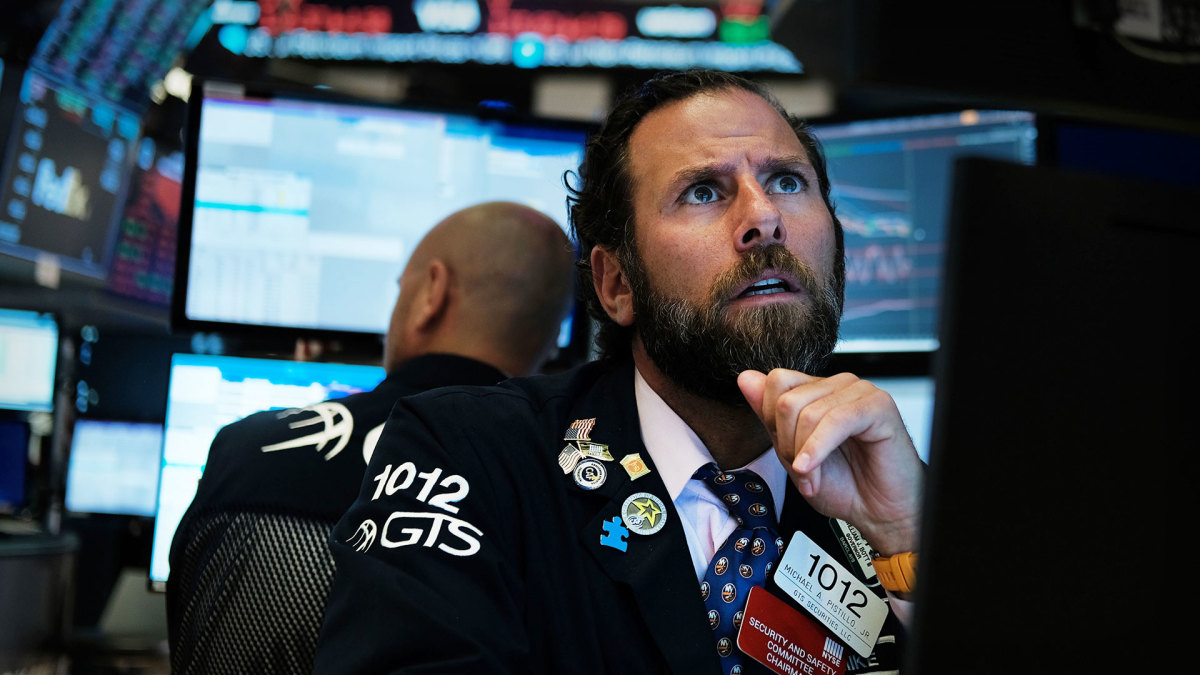
Investors pummeled U.S. stocks Wednesday, lopping over 420 points from the Dow Jones Industrial Average, after a hotter-than-expected March inflation report that will likely force a major reset of Federal Reserve interest rate outlooks.
The harsh reaction, which also lifted benchmark 10-year Treasury-note yields to their highest levels since early November, seems to ignore one key aspect of the broader inflation story.
And that could be bad news for stocks heading into the first quarter earnings season.
Headline inflation quickened to an annual rate of 3.5% last month, the Commerce Department said on April 10, while core price pressures, which strip out food and energy costs, were pegged at 3.8%.
"Over half of the increase in [Consumer Price Index] is gas and rents, which is keeping inflation north of 3%," said Jamie Cox, managing partner for Harris Financial Group in Richmond, Va. "Rates aren’t going higher, but the distance to a rate cut is another quarter away."

Rate traders seem to concur: CME Group's FedWatch tool pegs the odds of a June reduction at just 18.8%, down from around 51% before the inflation data release and 74% earlier in the year.
Faster inflation but stronger economy
The added inflation pressures, however, arrived parallel to a series of stronger-than-expected economic data releases for March, including the blowout 303,000 new jobs added last month and service-sector activity readings that S&P Global economist Chris Williamson said point to a first-quarter GDP growth rate of 2%.
The Atlanta Fed's GDPNow forecasting tool puts current-quarter growth at around 2.4%.
"The U.S. economy is proving to be incredibly resilient and the market is taking care of the Fed’s dual mandate on its own, amid the recent spike in bond yields," said Skyler Weinand, chief investment officer at Regan Capital in Dallas. "With unemployment strong and commodity prices heating up, the Fed’s next move could very well be a rate hike to tame prices and keep inflation under control."
Related: Inflation report hammers Fed rate cut bets, sends stocks sharply lower
All this, of course, follows perhaps the Fed's most aggressive policy tightening on record. The economy has had to absorb rate hikes of around five percentage points over the past two years with a pickup in bond sales from the central bank's multitrillion-dollar balance sheet, or quantitative tightening.
In fact, should the first Fed move come in July or later, it will mark the longest period on record between a rate hike and a rate cut, topping the previous long from the start of the global financial crisis.
But an economy that can weather that rate-hike storm plus the blunting impact of tight Fed policy, and still grow by 3.4% over the final three months of last year, is in extraordinarily good shape.
So why are stocks so deeply in the red?
Faster inflation, regardless of origin, will likely compel the Fed to tweak its 2024 rate-cut forecasts, which currently suggest three quarter point reductions to the current base rate of 5.25% and 5.5%.
Stocks face new rate slide rule
As a result, financial market arithmetic needs to apply a higher so-called risk-free rate to the pricing of assets ranging from stocks and bonds to loans and mortgages.
A higher risk-free rate [the interest rate an investor would expect from safe U.S. Treasury bonds), using a basic present-value calculation, results in lower real-time prices.
That likely means investors think the S&P 500, which trades at a multiple of around 21.2 times the projected rate of profit over the next 12 months, is overvalued.
"Valuations are so stretched right now that anything less than perfection from economic data or any geopolitical noise can create substantial and quick selloffs," said David Bahnsen, chief investment officer at Bahnsen Group in Newport Beach, Calif.
"This market touchiness should not be confused with directional weakness, which we are not seeing right now, as markets have been strong all year despite substantial changes in Fed rate-cut expectations and a mixed bag of returns for last year's so-called Magnificent 7" tech stocks, he added.
Related: Inflation report will disappoint markets (and the Fed)
And that by extension puts a great deal of pressure on first quarter earnings season and profit outlooks for the coming year for the stock market to hold on to its hard-won gains this year.
LSEG data suggests that collective first-quarter S&P 500 profits will likely rise around 5% from the year-earlier level to a share-weighted total of $457.4 billion. For the three months ending in June, that estimated tally rises to a growth rate of 10.3% and profits of $494.1 billion.
Earnings season in renewed focus
In other words, if investors are willing to sell stocks based on data that suggest economic strength, they're even more likely to extend those sales if earnings growth fails to match Wall Street forecasts.
"Equity indexes are increasingly dependent on the upcoming earnings season, as companies must deliver to substantiate higher valuations," said John Lynch, chief investment officer for Comerica Wealth Management in Charlotte.
"Any profit disappointment likely brings the possibility of a near-term correction in the 5-6% range for the S&P 500 Index," he added.
More Wall Street Analysts:
- Analyst unveils Nvidia stock price 'line in the sand'
- Analyst revamps homebuilder stock price target before Fed rate call
- Analysts revamp Nvidia price targets as Blackwell tightens AI market grip
Richard Saperstein, chief investment officer at Treasury Partners in New York, agrees, noting that recent market gains have been fueled by a combination of artificial intelligence technology exuberance, declining inflation, and the prospect of Fed rate cuts.
"But the recent resiliency of inflation reduces the immediacy of rate cuts, which puts more pressure on earnings to drive future market gains," he cautioned.
"With stock valuations near record highs, the burden is on earnings to drive further rises in stock prices," Saperstein said. "Wall Street is expecting 10% earnings growth in both 2024 and 2025, which may not be enough fuel to drive any meaningful stock-market gains from current levels."
Related: Veteran fund manager picks favorite stocks for 2024







